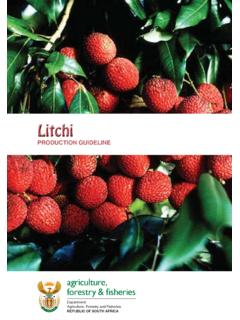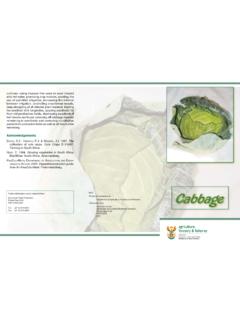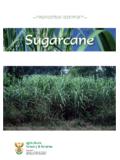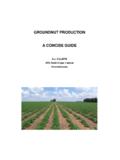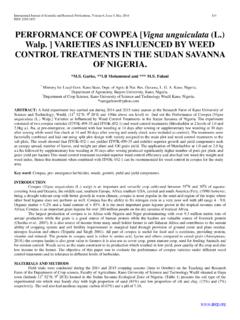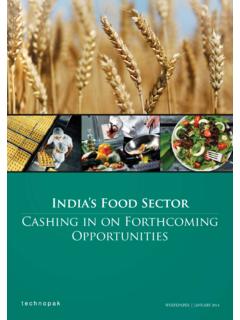Transcription of (Vigna subterranea)
1 (Vigna subterranea )- production GUIDELINE -Bambara Groundnutsagriculture,forestry & fisheriesDepartment: Agriculture, Forestry and FisheriesREPUBLIC OF SOUTH AFRICA2016 Department of agriculture, forestry anD fisheriesBambara Groundnuts (Vigna subterranea )2016 Printed and published by Department of Agriculture, Forestry and FisheriesDesign and layout by Communication Services Private Bag X144, Pretoria 0001 DISCLAIMER This document has been compiled by the Department of Agriculture, Forestry and Fisheries and every effort has been made to ensure the accuracy and thoroughness of the information contained herein. The department cannot, however, be held responsible for any errors, omissions or inaccuracies in such information and data, whether inadvertent or otherwise. The Department of Agriculture, Forestry and Fisheries, therefore, accepts no liability that can be incurred resulting from the use of this 1: General aspects Classification 1 Origin and distribution 1 production levels 1 Major production areas in South Africa 2 Varieties and cultivars 2 Description 3 Climatic requirements 5 Soil requirements 5 Part 2: Cultivation practices Propagation 5 Soil preparation 5 Planting 6 Fertilisation 6 Irrigation 6 Weed control 6 Pest control 7 Disease control 7 Other cultivation practices 8 Harvesting 8 Part 3: Post-harvest handling Sorting 9 Packing 9 Storage 9 Marketing 9 Part 4: Utilisation 9 production schedule 10 References 10 1 Part I: General aspects1.
2 CLASSIFICATIONS cientific name: Vigna subterranea (L.) VerdcCommon names: Bambara groundnut; Jugoboon, ditloo-marapo, izindlubu, Indlubu, jugo bean, nduhu, phonda, ndlowu, njugo, tindlubu, inhlowa2. ORIGIN AND DISTRIBUTIONB ambara groundnut, (Vigna subterranea (L) Verdc.) originated from the African continent and has been cultivated in tropical Africa for centuries. The common name actually appears to be derived from a tribe, the Bambara, a district on the upper Niger near Timbuctoo. It was taken at an early date to Madagascar, probably by the Arabs. It has reached Brazil and Surinam early in the seventeenth century and was later taken to the Philippines and Indonesia. It is the third crop among the grain legume crops of the African lowland tropics after the popular groundnut cowpea. The bambara groundnut has become less important in many parts of Africa because of the expansion of its production .
3 In recent years there has been renewed interest for cultivation in the arid savannah zones. 3. production LEVELS South AfricaIn South Africa it is produced by local people mostly for subsistence purposes. It was only in recent years that people started selling it in local markets ( boiled groundnuts). It is cultivated as an intercrop with maize, cowpeas and melons and as a sole crop. The size of Bambara plots range from 300 to 2500 m2 per farmer. The crop is not grown commercially in South Africa, they were neglected by National Research Institutes in the past and therefore, little was known about the optimum agronomic practices for this crop. InternationallyReliable production figures for Bambara groundnut are difficult to obtain, because the crop is mainly grown for human consumption and local markets. 2 The estimated production in Africa is about 330 000 tons. Nigeria leads in production with 100 000 tons followed by Burkina Faso, Ghana, Mali, Cameroon and Ivory Coast.
4 It is grown at subsistence level in almost all the sub-Saharan countries in Africa. 4. MAJOR production AREAS IN SOUTH AFRICAIn South Africa major production areas of Bambara groundnut is in the Limpopo, Mpumalanga, North West, Gauteng and KwaZulu-Natal provinces. In the Limpopo, Bambara groundnut is grown in Mopani, Capricorn, Waterberg and Vhembe districts. In Mpumalanga the production is extensively in Ehlanzeni district. In KwaZulu-Natal it is grown in Greytown, Msinga, Nkandla, Nguthuthu, Makhati, and Kosibaai areas. It is also grown on a minor scale in Umzinyathi and Illembe VARIETIES AND CULTIVARST here are two botanical varieties known as V. subterranean var. spontanea which includes wild varieties and V. subterranean var subterranean which includes cultivated varieties. The seven types of the bambara groundnut cultivated varieties include: Black: Early maturing, usually small to medium-sized kernels. Mainly one-seeded Red: Late maturing.
5 Kernels are large. A good yielder, however, it is prone to rotting onsite Cream/black eye: A large kernel and a good yielder Cream/brown eye: A moderate kernel and a good yielder Cream/no eye: Very small pods and kernels. It mainly produces one seed and yields are lower. Speckled/flecked/spotted: Purple colour predominates. Kernels are small and pods are mainly one-seeded. Brown: Continuous variation between light and dark brown. Ker nels are of medium to large bambara varieties, in general are location specific in their photoperiod requirements and consequently, high yielding varieties from one locality may fail to do well in another place. Therefore, emphasis has been given in selecting and improving local cultivars than the introduction of exotic Mature plantThe bambara groundnuts are herbaceous annual plants with creeping stems at ground level. It takes about three to six months to mature, de pending on weather conditions and the compact well-developed taproot with many profuse geotropic short lateral roots 20 cm long.
6 The roots form nodules for nitrogen fixation, in as sociation with African wild-type has lateral stems which develop from the leaves are trifoliate ( 5 cm long) and are attached to the stem by the petiole. The petioles are about 15 cm long, stiff and grooved, and the base is green or purple in colour. Leaves and flower buds arise alternately at each node. Leaves are pinnately trifoliate, glabrous with erect petiole and thickened at the base. Two stipels are subtend to the terminal leaflet, while only one is assigned to each of the two lateral leaflets. The oval leaflets are attached to the ranchis with marked pul vini. The terminal leaflet is larger than the lateral leaflets, with an aver age length of 6 cm and an average width of 3 The flowers are typically papilionaceous and are borne in a raceme on long, hairy peduncles which arise from the nodes on the stem. The branching types are usually self-pollinated while the spreading types are cross-pollinated by ants. Flowering starts 30 to 35 days after sowing and may continue until the 4end of the plant s life.
7 After fertilisation, the flower stem elongates. The sepal enlarges and the fruit develops above or just below the soil sur face. PodsThe pods usually develop underground after pollination and fertilisation. The unripe pod is yellowish green, with up to six pods, while the mature pods may be yellowish green or purple. The pod is small; about 1to 5 cm long, round or slightly oval shaped and wrinkled with mostly one or sometimes two seeds. Mature pods are indehiscent, wrinkled, ranging from yellowish to reddish dark brown in colour. SeedsThe seed is hard, smooth, usually round and varying in size, it could come up to 1,5 cm in diameter. It also varies in colour from white, cream, dark brown, red or black and may be speckled or patterned with a combination of the colours. The average seed mass is about 500 to 750 1: Bambara groundnut Essential partThe essential parts are the CLIMATIC TemperatureThe bambara groundnut is a fast growing plant, which requires warm temperatures and does not tolerate freezing temperatures during the growing season.
8 A growth period of 110 to 150 days is required for the crop to develop. The optimum temperature for germination of the bambara groundnut is 30 C to 35 C and sprouting can takes 5 to 21 days. An average day temperature that is ideal for the crop development is from 20 C to 28 C. Extreme temperatures cause dying of the leaves, resulting in the reduction of the biomass yield. Rainfall The bambara groundnuts need moderate rainfall from sowing until flowering. An annual rainfall of 500 to 1200 mm is required during the growing season. The plant toler ates heavy rainfall, but too much rainfall at harvest may result in yield losses. The bambara groundnut can also survive in hot dry areas where other crops would not SOIL REQUIREMENTSB ambara groundnut can be grown in poor, sandy to sandy loam and well-drained soil, which make it easier to harvest. Generally it performs better on poor soils than groundnuts. Yield of bambara groundnut on low fertility soils are generally higher than those of groundnuts grown on similar soil.
9 Bambara groundnut prefers a soil with a pH of 5,0 to 6, II: Cultivation practices1. PROPAGATIONThe bambara groundnut is propagated by SOIL PREPARATIONThe bambara gives the best yields on a deeply ploughed field with a fine seedbed. For compacted soil and weed infested areas, ploughing, followed by about two times of harrowing, it is recommended to ensure good germination and stand. A level seedbed is best; however, it can be planted on ridges when very wet conditions PLANTINGP lanting of the bambara groundnut can be done either as an intercropped plant with cereal crops or singly. It is planted from October to early December after good rainfall. Late planting results in poor establishment and significantly lower yields. Seeds should be treated with thiram (thiulin) before planting. In conditions of high mois ture levels and heavy soils (not recommended) seed can be planted 2,5 to 3,0 cm deep and 5,0 to 7,5 cm deep in sandy soil, with a recommended spacing of 10 to 15 cm in sin gle rows of 45 to 90 cm apart.
10 Germination takes seven to 15 2: Bambara groundnuts field4. FERTILISATIONL ocal data on fertilisation is lacking and therefore nutrient removal according to yield expectations can be used as a guide for P and K fertilisation. Excess nitrogen encourages vegetative growth in expense of crop yields. Because of a strong developed tap-root system shallowly placed, potassium is of no value. Phosphorus fertiliser has no beneficial effect on the yield as well. 5. IRRIGATIONNo statistical data on water management of the bambara groundnut is stored as the crop is commonly grown under rainfed WEED CONTROLWeed control is done chemically before planting, mechanically or by hand. Registered pre-emergent herbicides may be used for effective control of 7weeds on the bambara fields. Hand hoe can also be used but care should be taken when weeding around the plant, especially at flowering as the flower stalks are fragile and may break with rough handling. Hoeing should be done twice to keep the plot free from weeds.

